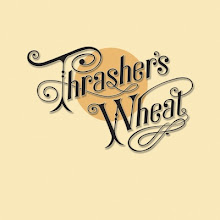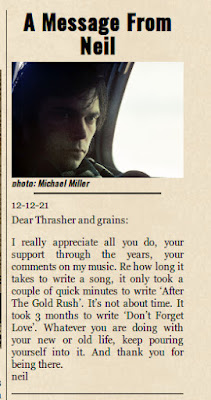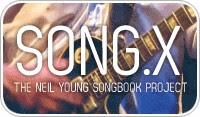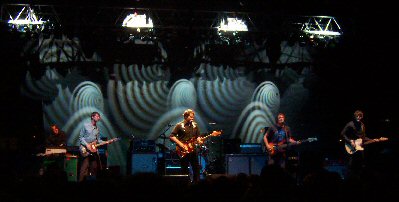"Neil Young's Harvest: A Multi-Voice Narrative" by Harvey Kubernik
Here's a multi-voice narrative on the Harvest album by Harvey Kubernik. Harvey Kubernik is the author of 19 books, including "Neil Young - Heart of Gold" (see TW review). We interviewed author Kubernik while TW celebrated Neil Young's 70th birthday back in 2015.
Neil Young: Harvest
By Harvey Kubernik Copyright 2022
On February 23, 1971 at the BBC Television Centre in London, producer/director Stanley Dorfman filmed Neil Young for BBC’s In Concert.
It was a pivotal U.K. small screen exposure for Young, who previewed some un-recorded material that would later surface on his epic 1972 album, Harvest.
Stanley Dorfman: At the time I was co-producing/directing Top Of The Pops with a guy called Johnnie Stewart. We started it in 1964. Around 1968, I had the thought of having a show of singer songwriters. And the first was with Leonard Cohen and Julie Felix. We then called them BBC In Concerts and the first one was with Randy Newman.
When we started this thing, BBC2 had just gone color. And the head of BBC2 was David Attenborough. And he liked folk music a lot. So I said, “Let’s do singer songwriters.” “Great.”
So, he sent me to California to find acts. And I met [David] Geffen and [Elliot] Roberts. It wasn’t a hard sell at all. The artists couldn’t get on television in England unless they had hit records.
The reason Neil Young, Joni Mitchell and the others connected very strongly with the English audience was because they were folk music oriented. British love folk music. The Scottish, the Welsh, the Irish. Plus, Neil Young citing Bert Jansch and the Shadows in his interviews didn’t hurt.
I loved the singer songwriters of the time. To me they were the poets. Laura Nyro. Brilliant songs last forever. With all these acts, I never dictated what they should do anyway. They’d come over and we’d have a lunch and a chat. We had marvelous lighting and they lit these things like portraits.
The other thing that I said to them before doing the program was that the editing would be very minimal. We had four cameras, five if you were lucky, no hand-held, so the only editing you would do was cut tunes out. Or put them in. So I told Neil and all the others, if they wanted to they could come to the editing room the next day and kind of decide how to structure the show. And they all liked doing that. Neil came. He was charming, lovely and delightful. Neil was not elusive in any of my dealings.”
In February 1971, Neil Young travelled to Nashville to tape The Johnny Cash Show. An ABC-TV national broadcast.
Neil Young had a star turn on the February 17, 1971 Johnny Cash on Campus episode, performing "The Needle and the Damage Done" and "Journey Through The Past.”
"One reason country music has expanded the way it has is that we haven't let ourselves become locked into any category,” Johnny Cash assured me during a 1975 interview I conducted with him in Anaheim California for the now defunct Melody Maker.
When I asked Johnny about his bold policy of booking established country artists and mixing relative new comers to his TV program artist lineup, Cash replied, “We do what we want.”
Guesting around Young’s screen stint Cash spot were James Taylor and Linda Ronstadt. Huddled around a microphone, these three blossoming talents gave a taste of the burgeoning singer/songwriter movement in rock.
While in Nashville Young took time to record some new material. Serendipity played its designated role as always; a chance encounter with an acquaintance of Elliot Roberts, veteran producer/engineer Elliot Mazer, introduced Neil to a new set of musicians who would influence his sound from this point on.
With Mazer handling the console at Quadraphonic Studios, Young laid down the tracks for what would become Harvest, his biggest seller and, for many, his most enduring work.
Elliot Mazer engineered and co-produced the Area Code 615 band. An album of highly respected Nashville session musicians, including Wayne Moss, David Briggs, Mac Gayden, Charlie McCoy, and Kenny Buttrey. [The BBC music program The Old Grey Whistle Test used their “Stone Fox Chase” as the theme].
In Nashville, Mazer, David Briggs, and Norbert Putnam built Quadraphonic Sound Studios.
Elliot Mazer: "I had a friend who smoked a lot of weed, which I wasn’t then, who played nothing but After The Gold Rush a lot. That was the first time I heard of Neil Young. I was interested in the voice. All of a sudden we read about Neil coming to Nashville to tape The Johnny Cash Show. I said, “We need to host a dinner.”
Neil, Linda Ronstadt, James Taylor and Tony Joe White attend, have dinner, and I get introduced to Neil. “You work with these Nashville guys. Can I get the studio tomorrow to mess around?” “Sure.” I moved a session to accommodate him. And called some musicians."
The future Stray Gators, a bunch of good ol’ boys covered all the musical bases: rascally Tim Drummond on bass, the timekeeper from Dylan’s immortal Blonde on Blonde, Kenny Buttrey, on silky smooth drums, pianist John Harris, guitar player Teddy Irwin and Ben Keith, Neil’s future right-hand-man on yowling steel guitar. They would set the table for their irascible leader on countless gigs and studio sessions. For now, it was time to bring in their first harvest, and they all knew it was something special.
Elliot Mazer: I knew “Heart of Gold” was a hit when Neil played it. His songs are generally an overpowering feeling. Kenny, Drummond, Ben, Teddy and I are in the control room. Small space. 12 feet by 20 feet. And Neil plays “Heart of Gold” and I look up and Kenny and I both at the same time put our fingers up as number one. We knew it. From then it was only a matter of time to get the thing done properly and out. Neil’s singing and playing on it was magnificent. His tempo was perfect. It was great. All we had to do was make sure we didn’t mess him up. I used a Neumann U67 or 87 microphone on his voice and rode his sound levels.
Neil played “Old Man” and sang it beautifully. I knew that was the take. I would know very early with Neil if it would be a take or not. I remember after that take, Neil came into the control room and saw Linda and James there and said, “Let’s record the backing vocals.” And we did the backing vocals right in the control room. James played six-string banjo on it.”
Linda Ronstadt as told to Gary Strobl, Henry Diltz archivist and photo librarian (who gave me his transcription in 2015):
Linda Ronstadt: “I sang in Nashville with Neil [at Quadraphonic]. We were doing The Johnny Cash Show and Neil was there. James Taylor was there. After we got finished with the TV show, Neil said, “I’m going to go record. Will you guys come along?” So we recorded “Old Man” and “Heart of Gold.” It took all night long. We didn’t get there until midnight. It was just before dawn, we came out of there and it had begun to snow.
I remember I had to be on my knees for most of the session because James and I were singing together. But James was so tall, he had to sit in a chair, then I’d have to bend over to sing, so I knelt on my knees. I could just reach the microphone. (laughs) James was bent over and I was kneeling. So I was really tired by the time we finished. Because it took hours. But we loved the music. It was so good. James was playing a banjo. Actually, it was a guitar with a banjo head on it with six strings. That’s James playing banjo that you hear on “Heart Of Gold.”
Two of the most beautiful, poignant songs. Neil is just the best. He’s my favorite writer from that time. I was a huge Neil Young fan. We didn’t think in those terms about those songs having an impact. I just went, “This is the best thing I’ve ever heard. I wanna be on it.” I was glad that I got to sing on it. I had sort of learned how to do or how Neil’s harmonies go by listening to them on the radio. (laughs). I was just glad to be part of it.”
Elliot Mazer: Neil and Jack Nitzsche went to London and did “A Man Needs a Maid” and “There’s a World” live with the London Symphony. Neil recorded “The Needle and the Damage Done” from a [January 30, 1971] concert at UCLA’s Royce Hall.
We did other tracks that were taped with the Stray Gators in California inside a barn on Neil’s ranch. We used a mobile truck with a UREI tube mixer. "'Words,” “Alabama” and “Are You Ready For The Country.” Nitzsche was on these sessions.”
Finally released in March, 1972, Harvest raced to Number One on Billboard, a defining moment for Neil Young.
“More than anyone in rock and roll, Neil Young has the guts to be romantic…If “Heart of Gold” is an admission, “A Man Needs a Maid” is an outcry… Harvest also sounds better than any other Neil Young album.” --- Jimm Cushing, University of California Santa Cruz, The City On A Hill Press, April 13, 1972.
Harvey Kubernik is the author of 20 books, including Leonard Cohen: Everybody Knows published in 2014 and Neil Young Heart of Gold during 2015. Kubernik also authored 2009’s Canyon Of Dreams: The Magic And The Music Of Laurel Canyon and 2014’s Turn Up The Radio! Rock, Pop and Roll In Los Angeles 1956-1972. Sterling/Barnes and Noble in 2018 published Harvey and Kenneth Kubernik’s The Story Of The Band: From Big Pink To The Last Waltz. In 2021 the duo wrote Jimi Hendrix: Voodoo Child for Sterling/Barnes and Noble.
Otherworld Cottage Industries in 2020 published Harvey’s book, Docs That Rock, Music That Matters, featuring interviews with D.A. Pennebaker, Chris Hegedus, Albert Maysles, Murray Lerner, Morgan Neville, David Leaf, Dick Clark, Curtis Hanson and Michael Lindsay-Hogg.
Kubernik’s writings are in several book anthologies, including The Rolling Stone Book Of The Beats and Drinking With Bukowski. Harvey wrote the liner note booklets to the CD re-releases of Carole King’s Tapestry, The Essential Carole King, Allen Ginsberg’s Kaddish, Elvis Presley The ’68 Comeback Special, The Ramones’ End of the Century and Big Brother & the Holding Company Captured Live at The Monterey International Pop Festival.
- Details on the 50th Anniversary Edition of the album Harvest
- HARVEST Outtakes by Neil Young: "Journey Through The Past"
- Unboxing Video: Harvest 50th Anniversary Edition by Neil Young
- ESSAY: Neil Young’s Harvest at Age 50 by Harvey Kubernik
- Neil Young Remembers "The Innocence": WORDS
- Neil Young's "Song of the Day": "Are You Ready The Country?" + VIDEO
- Neil Young's Memories of Recording Harvest Album: "Sessions of a Lifetime"
- Neil Young's Song Of The Day: "Heart of Gold" + 1971 Interview
- Unboxing Video: Harvest 50th Anniversary Edition by Neil Young
- INTERVIEW: Neil Young Says He Was Offered Millions to Tour Harvest Album | AARP
Labels: album, harvest, neil young, review

































 Human Highway
Human Highway

















 Concert Review of the Moment
Concert Review of the Moment





 This Land is My Land
This Land is My Land

 FREEDOM In A New Year
FREEDOM In A New Year









 *Thanks Neil!*
*Thanks Neil!*




![[EFC Blue Ribbon - Free Speech Online]](http://www.thrasherswheat.org/gifs/free-speech.gif)











 The Unbearable Lightness of Being Neil Young
The Unbearable Lightness of Being Neil Young Pardon My Heart
Pardon My Heart



 "We're The Ones
"We're The Ones  Thanks for Supporting Thrasher's Wheat!
Thanks for Supporting Thrasher's Wheat!




 This blog
This blog 
 (... he didn't kill himself either...)
#AaronDidntKillHimself
(... he didn't kill himself either...)
#AaronDidntKillHimself









































































 Neil Young's Moon Songs
Neil Young's Moon Songs




 Civic Duty Is Not Terrorism
Civic Duty Is Not Terrorism Orwell (and Grandpa) Was Right
Orwell (and Grandpa) Was Right


 What's So Funny About
What's So Funny About 



6 Comments:
I enjoyed the telling of the small part played by David Attenborough in the Neil Young story. Two great heroes of our time.
Pick yer seats for the Harvest Time screening! Tickets went live today.
Very interesting quotes...hadn't heard some of that. Looking forward to the movie and tickets are onsale in Chapel Hill, too.
Just to be clear there is an L.A. David Briggs and a Nashville David Briggs. Their histories kind of intertwine. Once had a long interview with the Nashville David Briggs thinking he was the LA one. The Nashville David Briggs is also connected with some J.J. Cale stories but many assume it is the LA David Briggs. There was an industry book done of record producers and they mixed the two David Briggs into one.
Wonder if both David Briggs are in the Harvest movie?
@ Jim - right, the Briggs confusion seems never ending.
and maybe the Harvest movie might clarify? not that anyone could tell the difference visually from 50 years ago?
I reluctantly bought the 50 year Anniversary of Harvest. Everything in package with set I have heard multiple times.The BBC concert has been around forever. The Harvest Time DVd I believe is just an extension of the barn jams which you can view in Archives volume #1. Let's get on with Archives volume #3 & stop the repeats.
Ever since the Return to Greendale release I have been sceptical about purchasing more concert DVD's.The sound quality of the DVD is very poor & not worth watching because of it. I was thought Neil said something about a new release because this. Kinda like the issue of Way Down in the Rust Bucket he did a new release because of sound quality. I was proud of Neil for standing up and doing the right thing with a replacement DVD. Doesn't appear he is going to stand up & do the same for the poor sound quality of Return to Greendale.
Post a Comment
<< Home